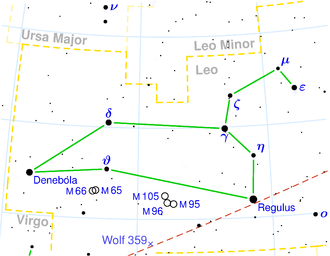NGC 3130
| Galaxy NGC 3130 |
|
|---|---|

|
|
| SDSS recording | |
| AladinLite | |
| Constellation | lion |
|
Position equinox : J2000.0 , epoch : J2000.0 |
|
| Right ascension | 10 h 08 m 12.3 s |
| declination | + 09 ° 58 ′ 37 ″ |
| Appearance | |
| Morphological type | S0 / a |
| Brightness (visual) | 13.4 mag |
| Brightness (B-band) | 14.3 mag |
| Angular expansion | 1 ′ × 0.6 ′ |
| Position angle | 30 ° |
| Surface brightness | 12.7 mag / arcmin² |
| Physical data | |
| Redshift | 0.027322 ± 0.000147 |
| Radial velocity | 8191 ± 44 km / s |
|
Stroke distance v rad / H 0 |
(361 ± 25) · 10 6 ly (110.6 ± 7.8) Mpc |
| history | |
| discovery | John Herschel |
| Discovery date | January 19, 1828 |
| Catalog names | |
| NGC 3130 • UGC 5468 • PGC 29475 • CGCG 064-072 • MCG + 02-26-026 • 2MASX J10081231 + 0958374 • GALEX MSC J100812.39 + 095837.4 | |
NGC 3130 is a lenticular galaxy of the Hubble type S0 / a in the constellation Leo on the ecliptic . It is around 361 million light years away from the Milky Way and has a diameter of around 105,000 light years .
The galaxy IC 596 is located in the same area of the sky .
The object was discovered by John Herschel on January 19, 1828 .
